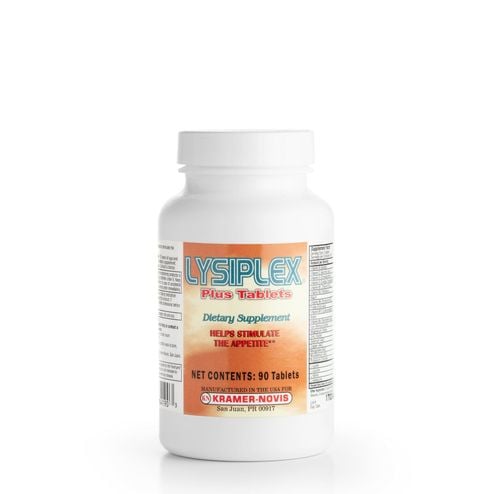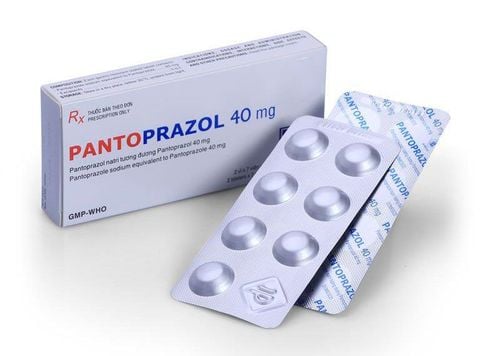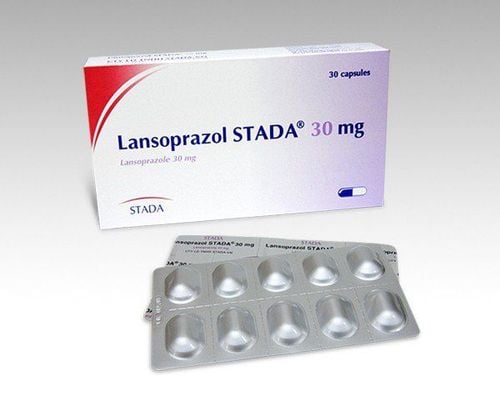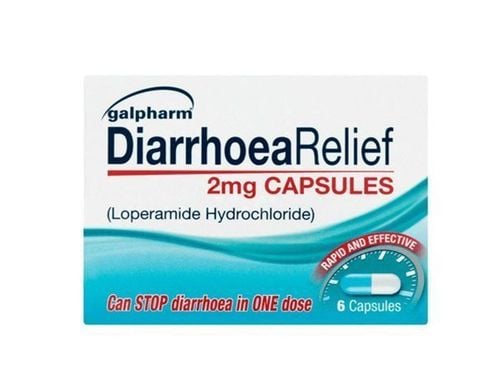This is an automatically translated article.
Those who are suffering from acute duodenal ulcer, benign gastric ulcer and maintenance treatment must be interested in Umetac 150 and Umetac 300. So what are the effects of this Umetac? What kind of umetac is good and how to use it?
1. What is Umetac 300 and Umetac 150?
Umetac 300 and Umetac 150 both have Ranitidine Hydrochloride as the main ingredient. It is a competitive inhibitor that reverses the action of histamine at histamine H2 receptors, including those on gastric cells. They work by reducing the amount of acid in your stomach. Used to relieve symptoms of indigestion and heartburn caused by too much acid in the stomach.
Ranitidine tablets do not reduce serum Ca ++ in the hypercalcemic state and are also not anticholinergic.
Each Umetac 150 mg tablet for oral administration contains 168 mg of Ranitidine HCl equivalent to 150 mg of Ranitidine. Each tablet also contains the inactive ingredients microcrystalline cellulose, croscarmellose sodium, magnesium stearate, Opadry ® 200 Orange 203A530006 (Polyvinyl alcohol, talc, titanium dioxide, glycerol monostearate, sodium lauryl sulphate, FD&C yellow 6 and yellow oxide yellow). iron), purified water.
Each Umetac 300 mg tablet for oral administration contains 336 mg of Ranitidine HCl equivalent to 300 mg of Ranitidine. Each tablet also contains the inactive ingredients microcrystalline cellulose, croscarmellose sodium, magnesium stearate, Opadry ® 200 Yellow 203A520014 (Polyvinyl alcohol, talc, titanium dioxide, glycerol monostearate, sodium lauryl sulphate, FD&C yellow 5 and FD&C Blue 1) , pure water.
Absorption: Ranitidine tablets are absorbed 50% after oral administration, compared with intravenous (IV) administration with mean peak concentrations of 440 to 545 ng/mL occurring 2 to 3 hours after a 150 mg dose. . Absorption is not significantly impaired with food or antacids. Propantheline slightly slows and increases peak blood levels of Ranitidine, possibly by slowing gastric emptying and transit time.
Excretion: The major route of excretion is urine, with approximately 30% of an oral dose recovered in the urine as unchanged drug in 24 hours. Renal clearance is about 410 mL/min, indicating active tubular secretion. The half-life is 2.5 to 3 hours.
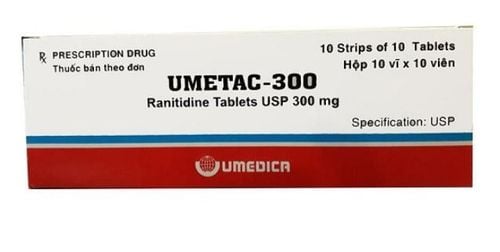
Umetac được sử dụng trong điều trị một số bệnh lý đường tiêu hóa
2. The effects of the drug Umetac
2.1. Indications Umetac Tablets are indicated in:
With adults
Short-term treatment of duodenal ulcer in active period. Most patients recover within 4 weeks. Studies to date have not evaluated the safety of Ranitidine for uncomplicated duodenal ulcers of more than 8 weeks duration. Maintenance treatment of duodenal ulcer patients at a reduced dose after healing of acute ulcers. Treatment of pathological conditions with hypersecretion. (eg, Zollinger-Ellison syndrome and systemic dystrophy). Short-term treatment of active, benign gastric ulcers. Most patients recover within 6 weeks and the usefulness of further treatment has not been demonstrated. Studies to date have not evaluated the safety of Ranitidine for uncomplicated, benign peptic ulcers of more than 6 weeks duration. Maintenance therapy for patients with peptic ulcers at a dose that is tapered off after healing of acute ulcers. Placebo-controlled studies were performed for 1 year. Treatment of GERD. Symptomatic relief usually occurs within 24 hours of initiating treatment with Ranitidine Tablets USP, 150 mg twice daily. Treatment of esophagitis diagnosed by endoscopy. Symptomatic relief of heartburn usually occurs within 24 hours of initiating treatment with Ranitidine Tablets USP, 150 mg 4 times/day. Children (3 to 18 years)
Short-term treatment of peptic ulcers Treatment of gastroesophageal reflux disease, including reflux esophagitis and symptomatic relief of gastroesophageal reflux disease manage . 2.2. Contraindications Umetac is contraindicated in patients with known hypersensitivity to the drug or any of its ingredients.
2.3. Undesirable side effects Lymphatic and blood system disorders
Very rare: Changes in some blood counts (leukopenia, thrombocytopenia). In a few cases there is agranulocytosis or leukopenia, sometimes with myeloproliferative hypoplasia or aplasia.
Immune system disorders
Rare: Hypersensitivity reactions (urticaria, angioedema, fever, bronchospasm, hypotension and chest pain).
Very rare: Anaphylaxis
Psychosis
Very rare: Reversible mental confusion, depression and hallucinations.
Reported mainly in critically ill patients, in the elderly and in nephrotic patients.
Nervous system disorders
Very rare: Headache (sometimes severe), dizziness and reversible dyskinesia.
There are also disorders of the eyes, heart, blood vessels, liver and biliary...

Người sử dụng Umetac 300 có thể gặp một số tác dụng ngoài ý muốn
2.4. Drug Interactions Umetac has the potential to affect the absorption, metabolism, or renal excretion of other drugs. Altered pharmacokinetics may require dose adjustment of the affected drug or discontinuation of therapy.
Mechanisms of drug interactions include:
Inhibition of the cytochrome P450-linked mixed-function oxygenase system Umetac at usual therapeutic doses does not potentiate the effects of drugs inactivated by this enzyme system such as diazepam, lidocaine, phenytoin, propranolol and theophylline.
Alterations in prothrombin time have been reported with coumarin anticoagulants (eg, warfarin). Because of the narrow therapeutic index, close monitoring of prothrombin time increases or decreases during concomitant treatment with ranitidine is recommended.
Competition for tubular secretion Since ranitidine is partially eliminated by the cationic system, clearance of other drugs excreted by this route may be affected. High doses of ranitidine (eg those used in the treatment of Zollinger-Ellison syndrome) may decrease the excretion of procainamide and N-acetylprocainamide leading to increased plasma concentrations of these drugs.
Changes in gastric pH The bioavailability of some drugs may be affected. This may lead to increased absorption (eg, triazolam, midazolam, glipizide) or decreased absorption (eg, ketoconazole, atazanavir, delavirdine, gefitinib).
There is no evidence of an interaction between ranitidine and amoxicillin or metronidazole.
If high doses (2 g) of sucralfate are given concomitantly with ranitidine, its absorption may be reduced. This effect was not seen if sucralfate was administered after a 2-hour interval.

Umetac khi kết hợp sai có thể gây ra một số tương tác thuốc
3. How to use Umetac
Active Duodenal Ulcer: The current recommended adult oral dose of Umetac Tablets for duodenal ulcer is 150 mg twice daily. Alternate dose 300 mg 1 time / day after dinner or at bedtime. Studies in the US have demonstrated smaller doses to be equally effective in suppressing gastric acid secretion, and several foreign trials have shown that 100 mg twice daily is as effective as 150 mg dose. Antacids should be given as needed for pain relief
Maintenance of duodenal ulcer healing: The currently recommended adult oral dose is 150 mg at bedtime.
Pathological hypersecretory conditions (such as Zollinger-Ellison syndrome): The currently recommended adult oral dose is 150 mg twice daily. In some patients, Umetac, 150 mg, may be needed more often. Dosage should be adjusted according to individual patient needs, and should continue as long as clinically indicated. Doses up to 6g/day have been used in critically ill patients.
Benign gastric ulcer: The currently recommended adult oral dose is 150 mg twice daily.
Maintenance of peptic ulcer healing: The currently recommended adult oral dose is 150 mg at bedtime.
GERD: The currently recommended adult oral dose is 150 mg twice daily.
Erosive esophagitis: The currently recommended adult oral dose is 150 mg 4 times/day.
Maintenance Treatment of Erosive Esophagitis: The currently recommended adult oral dose is 150 mg twice daily.
Use in Children: Safety and effectiveness of Ranitidine Tablets have been established in the age group of 1 month to 16 years. There is insufficient information on the pharmacokinetics of Umetac Tablets in neonates (less than 1 month of age) to make dosage recommendations.
Treatment of duodenal and gastric ulcers: The recommended oral dose for the treatment of active gastric and duodenal ulcers is 2-4 mg/kg twice daily to a maximum of 300 mg/day. This recommendation is drawn from clinical studies in adults and pharmacokinetic data in pediatric patients.
Maintenance of duodenal and gastric ulcer healing: The recommended oral dose to maintain healing of duodenal and gastric ulcers is from 2 to 4 mg/kg once/day to a maximum of 150 mg/ day. This recommendation is drawn from clinical studies in adults and pharmacokinetic data in pediatric patients.
Treatment of GERD and erosive esophagitis: Despite limited data on these conditions in pediatric patients, the published literature supports dosages of 5 to 10 mg/kg/day, usually divided into 2 times.
Dosage adjustment for patients with impaired renal function: On the basis of experience with a group of patients with severe renal impairment treated with Umetac Tablets, the recommended dosage in patients with Creatinine clearance <50mL/min is 150 mg every 24 hours. If the patient's condition requires, the dosing frequency may be increased to every 12 hours or even more with caution. Hemodialysis reduces circulating levels of Ranitidine. Ideally, the dosing schedule should be adjusted so that the time of scheduled dosing coincides with the end of hemodialysis.
Elderly patients are more likely to have decreased renal function, so care should be taken in dose selection and it may be helpful to monitor renal function.
Please dial HOTLINE for more information or register for an appointment HERE. Download MyVinmec app to make appointments faster and to manage your bookings easily.




